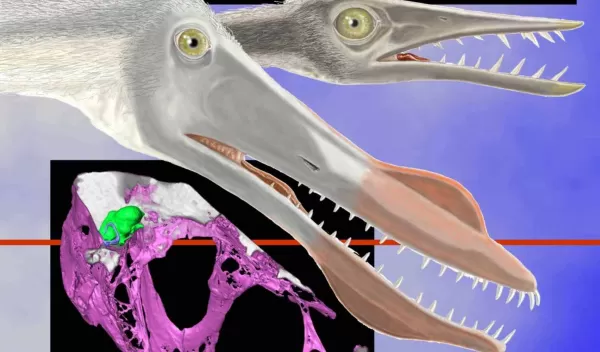
Pterosaur Heads Were Uniquely Adapted for Flight
With its 13-foot wing span, an ancient flying reptile soars above a lake, scanning for dinner as its shadow glides across the water's surface below. Eying a fish, the aerobatic reptile, called a pterosaur, dives through the air, its shadow shrinking and darkening until--splash! The fish is in the pterosaur's beak, which resembles a cross between a pelican's bill and a crocodile's snout.
While such a scene would have occurred more than 100 million years ago, a study in 2003 has painted a clearer picture of what went on inside the pterosaur's head. When scientists using fossil skulls examined the neuroanatomy responsible for flight control and prey spotting, they found key structures to be specialized and enlarged, a discovery that could revise views of how vision, flight and the brain itself evolved.
Led by Lawrence Witmer of Ohio University, the researchers took a high-tech look through two skulls of separate species of pterosaurs. Using computerized images derived from X-rays, they peered into the vestibular apparatus, the passageways and chambers responsible for maintaining equilibrium. The scientists also dove "virtually" into the brain cavity to analyze the regions responsible for coordinating wing movements, for scanning the environment and for "stabilizing gaze," a necessity for airborne predators.
The research team included Sankar Chatterjee of the Museum of Texas Tech University and Jonathan Franzosa and Timothy Rowe from the University of Texas (UT) at Austin. The trio put the two skulls through the scanner at the NSF-supported High-Resolution X-ray Computed Tomography Facility at UT Austin.
"It is a beautifully integrative study," said William Zamer, who directs NSF's Ecological and Evolutionary Physiology program, which supported the research. "It uses paleontological information, state-of-the-art technology to reconstruct the brain anatomies, and existing knowledge of the working of the semicircular canals to draw fascinating inferences about how these organisms may have performed when they were alive."
Some differences between the two pterosaurs were outwardly apparent.
The skull of Rhamphorhynchus muensteri, a species found in Jurassic formations in Germany, is about five inches long. From its broad back, the skull tapers steadily to a pointed beak. On the other hand, the skull of Anhanguera santanae, found in the Cretaceous deposits of Brazil, is almost two feet long. Narrower and triangular in cross-section, it tapers toward both the front and the back.
"Anhanguera was quadrupedal and didn't walk solely on its back feet," Witmer said. "It had long forelimbs, though, and so was canted into a more upright position than was the shorter-armed Rhamphorhynchus."
Anhanguera's head hung at a downward slant, which likely enhanced its binocular vision and terrestrial agility. "The major evidence for the down-turned head comes from the orientation of the inner ear canals," he said. Those, however, remain deep within Anhanguera's rock head, visible only virtually.
To examine the skulls' chambers encased within the mineralized fossils, the researchers used non-invasive X-ray computerized axial tomography--more commonly known as "CAT scans." Custom-built to explore the internal structure of natural--and often fossilized--objects, the scanner at the Texas facility has greater resolution and penetrating power than a conventional medical-diagnostic CAT scanner.
The scanner feeds its data to DigiMorph, an NSF-funded digital library that develops and makes available 2-D and 3-D structural visualizations of living and extinct animals, mostly vertebrates. DigiMorph turned the scanners' deep and detailed views into digitized "virtual" endocasts, which revealed more differences between the vestibular networks in the two skulls.
For example, the orientation of the vestibular apparatus relative to the long axis of the skulls varied. This is particularly noteworthy because of the semicircular canals. These fluid-filled chambers, which all vertebrates have in their inner ears, serve as levels to help the brain determine which way is up, arrange an appropriate rate of acceleration and maintain equilibrium.
In Rhamphorhynchus, the orientation of the canals suggests a level-headed approach to flying. In Anhanguera, it suggests a head turned strongly downward both in flight and when on the ground.
The researchers also found in both animals another greatly enlarged neurological structure critical to flight. Called the flocculus, this lobe of the cerebellum has important connections with the vestibular apparatus, the eye muscles and neck muscles, which work together to stabilize and sharpen an image of prey upon the retina.
The flocculus may also connect to the membrane covering the wing, gathering massive amounts of sensory input on body orientation amidst aerodynamic forces. In both pterosaur subjects, the flocculi occupy about 7.5 percent of total brain mass; in birds, they occupy about 2 percent or less.
According to the report in the journal Nature, "Enhancement of such mechanisms seems reasonable in these two visually oriented pterosaurs given their apparent foraging style of aerial fish-eating."
--Sean Kearns


